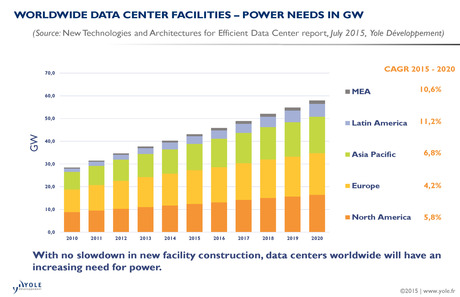Will DC grid be a solution for data centres?

Ever-increasing internet traffic and the video streaming boom is set to encourage large data centre investments in the coming years, according to Yole Développement (Yole).
The market research and strategy company has released an analysis of the trends, market and opportunities of development for the next generation of data centres, including new architectures and technologies.
The report ‘New Technologies & Architectures for Efficient Data Centres’ presents market forecasts between 2010 and 2020; the key players and their market share for servers, UPSs and cooling systems; and an overview of each technology’s technical evolution, including silicon photonics, non-volatile memory (NVM) and wide-bandgap (WBG) materials.
Yole said that last year, around US$143bn was invested worldwide in new data centre projects. In particular, internet companies like Amazon, Facebook and Google are leading the investment in next-generation ‘green’ data centres.
“At Yole, we clearly identify a trend to develop larger data centres with an increased server concentration,” said Mattin Grao Txapartegi, technology & market analyst at Yole.
Analysts say this trend has a direct impact on the blade server market for data centres, which may anticipate a 2015–2020 CAGR of 10.8%, while the entire server market may increase by 2.3%.
Global server market share for data centres is also set to increase to almost 35% by 2020, compared to less than 20% in 2014.
“Our regional split shows that North America, particularly the US, has the biggest share of the server market at 34% (US$3.5bn),” said Txapartegi.
“Europe, however, leads the UPS equipment and cooling systems markets for data centres. In fact, Europe’s large UPS (up to 100 kVA) market was estimated at US$931m in 2014.”
Yole has also identified a smaller, high-potential parallel market consisting of ‘container data centres’. These containers are rugged, portable, energy-efficient plug-and-play solutions that have enjoyed rising sales over the last few years. Hewlett Packard (HP) leads this new market, which will enjoy a 23.2% CAGR from 2015 to 2020, with Huawei following closely behind.
Yole says traditionally rigid AC architectures are evolving towards flexible and modular solutions since established data centres are not able to enlarge their IT equipment, as the power architecture and the centralised cooling system were designed for rated power. The company says such designs cannot be modified either and present many inefficiencies when servers work in ‘low load’ mode, while modularity brings a fresh approach to data centre design, enabling the incorporation of additional servers when needed.
“At Yole, we clearly identify a trend to develop larger data centres with an increased server concentration,” said Txapartegi.
“Other solutions exist to minimise distribution chain power loss, such as DC grid data centres. Thanks to a simplified architecture and fewer conversion steps, losses can be reduced by 20%. Players like ABB, NTT and Huawei have several DC grid data centre demonstrators that use a 380 VDC distribution voltage.
“The main barrier for this new architecture is the lack of appropriate DC components, especially 400 VDC safety breakers.”
A detailed description of this report is available at i-micronews.com.
Luminous running trail utilises IoT tech, wins awards
The Jinji Lake Luminous Trail, a project developed by China's Suzhou Industrial Park, has...
Are we dangerously dependent on submarine cables?
A new study warns that submarine communication cables are increasingly vulnerable to both natural...
Rethinking data centre sustainability
In this interview, Terry Maiolo, VP & General Manager for Asia Pacific at cloud computing...




